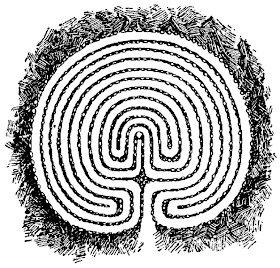Atlas Obscura serves up fascinating posts every day. Today they wrote about the island of Gotland, Sweden, a peculiarly temperate place where roses bloom in December. The area is littered with ancient mounds, ship burials, iron age forts, and early churches. It's also home to one of the oldest examples of a Trojeborg labyrinth in Sweden.
The Atlas Obscura write-up makes it sound like "Trojeborg" is a specific, ancient site. In fact, it's a common name applied to a certain style of labyrinth found all over Europe (and, indeed, the world), although the one in Gotland is both ancient and famous. The name translates quite simply as "Troy Town," which is what similar, turf-cut mazes in England are called. This classical style of labyrinth has been associated with the city of Troy for at least 2600 years, and was once believed to depict the elaborate system of maze-like walls protecting Troy.
The most bizarre aspect of the labyrinth is the way it keeps cropping up in ancient sites all over the world. This page has a good compilation of maze pictures that shows the immense diversity and wide dispersal of the design. (I'll pass over the website author's theory that the maze is actually a map of Atlantis without comment.) Jeff Saward also has a good site with pictures and information about the turf mazes of England.
The maze in general--and this style in particular--has long held intense meaning for diverse civilizations, although the exact nature of that meaning is still open to speculation. To be precise, the word "maze" usually implies a puzzle to be solved, while the word "labyrinth" implies a winding path to be followed. There is only one path through the design above, therefore it is more properly called a labyrinth.
To me, the design has always seemed somewhat like a stylized tree, with the entrance forming the trunk. Since I come from a Judeo-Christian tradition, I associate this with the two trees of the Garden of Eden, particularly the Tree of Life, which is also mentioned in the Book of Revelation. A Buddhist, on the other hand, might interpret it as a bodhi tree. Others see anatomical motifs, such as the human brain or even genitalia. (Although to paraphrase Freud, "Sometimes a maze is just a maze.")
It would be silly to deny that the design had deep--most likely religious--meaning to multiple civilizations for thousands of years. People don't carve a random symbol into stone, build giant versions of it, make it the focus of ritual, and mint coins depicting it unless the object means something. It may be the path a spiritual seeker follows, or the complex nature of a human life, but its persistence throughout much of human history is undeniably intriguing.


No comments:
Post a Comment
All ad-driven comments will be marked as spam and deleted.
Note: Only a member of this blog may post a comment.